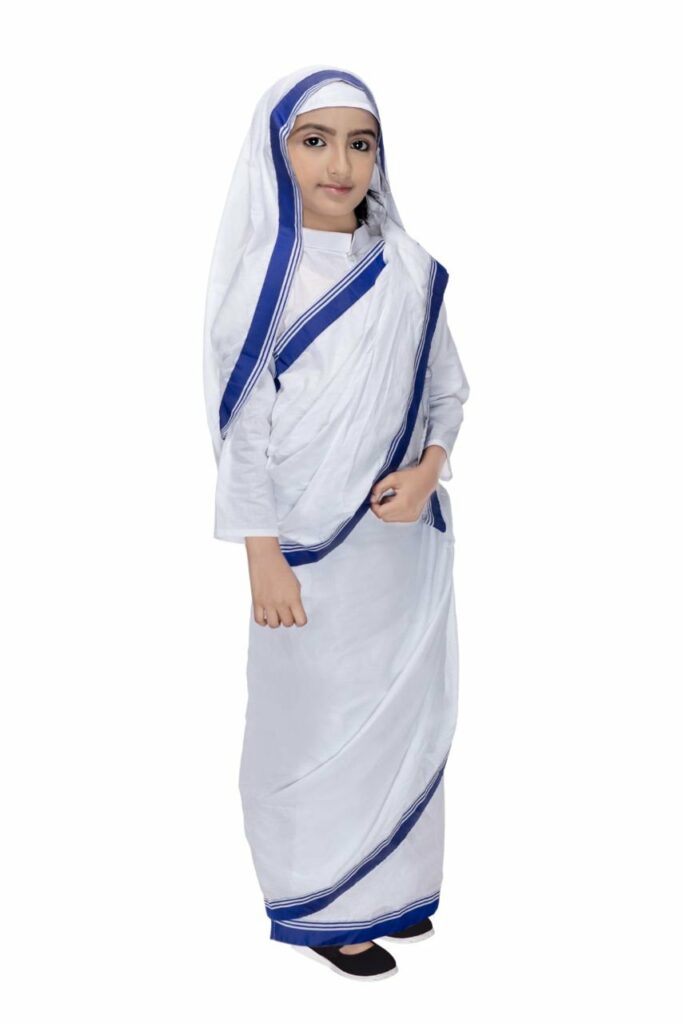
Mother Teresa, the epitome of compassion and selflessness, was recognized not only for her profound humanitarian work but also for her distinct attire—a simple, blue-bordered white saree with a crucifix pinned to it. This iconic dress became emblematic of her dedication to serving the poorest of the poor and embracing a life of humility and empathy.
A Habit Formed: Loreto Influence
The origins of Mother Teresa’s dress trace back to her early days as a nun in the Loreto order. Before founding the Missionaries of Charity in 1950, she taught at St. Mary’s School in Kolkata. Her habit during her time with the Loreto order consisted of a white saree with a blue border, adhering to the traditional attire of the order.
The Transformation: A Distinct Identity

However, as she embarked on her independent journey to aid the destitute, Mother Teresa sought to create a distinct identity for her newly formed congregation. She continued wearing the same simple white saree, now without the Loreto blue border. The significance of the color white was in line with her belief in purity, simplicity, and service to all regardless of their faith or background.
Symbolism in Simplicity: Meaning of the Attire
The attire was more than just clothing; it symbolized her commitment to live among the poor and destitute, to be one with them in their suffering. The absence of any ornamentation or luxury reflected her vow of poverty and dedication to living a life of austerity.
The Crucifix: Sign of Faith and Devotion
The addition of a small crucifix pinned to her saree further emphasized her devotion to Christ and served as a reminder of the spiritual foundation of her mission. It was a symbol of her faith and a testament to her unwavering belief in the teachings of Christianity.
Beyond Clothing: A Message of Compassion
Mother Teresa’s attire became iconic not only for its simplicity but also for the message it conveyed—a message of love, compassion, and selfless service. It transcended cultural and religious boundaries, becoming a universal symbol of humanity.
Humility Amid Recognition
Despite the global recognition of her work and attire, Mother Teresa remained humble, attributing her impact not to her clothing but to the compassion and love that fueled her actions.
Legacy in Fabric: Continual Inspiration
Even after her passing, Mother Teresa’s dress continues to hold significance. It is displayed in exhibitions and museums worldwide, a tangible reminder of her legacy and the enduring impact of her humanitarian efforts.
How to wear a sari like Mother Teresa?
Mother Teresa’s sari was a simple and iconic garment that embodied her humility and dedication to serving others. Here’s how you can wear a sari like her:
Choosing the Sari:
- Fabric: Opt for a cotton or khadi sari, similar to what Mother Teresa preferred. These fabrics are lightweight, breathable, and comfortable, especially in warmer climates;
- Color: Mother Teresa most often wore a white sari with blue borders. White symbolizes purity and peace, while blue represents faith and devotion. You can choose this classic combination or explore other colors with symbolic meanings, like saffron (renunciation) or green (hope);
- Pattern: Keep it simple. Solid colors or thin stripes were Mother Teresa’s preference. Avoid heavy embellishments or embroidery.
Draping the Sari:
- Pleating: The pleats of Mother Teresa’s sari were neat and uniform, typically starting from the left side of the waist and cascading down to the ankles. You can achieve this look by using safety pins or sari clips to secure the pleats in place;
- Pallu: The pallu (end piece) of the sari was draped over her left shoulder, often pinned near the elbow for a secure and graceful drape;
- Accessories: Keep it minimal. Mother Teresa rarely wore jewelry with her sari. A simple bindi or a small pendant with religious significance would be appropriate.
Additional Tips:
- Pay attention to the neatness of your attire. Iron the sari beforehand and ensure the pleats are crisp and even;
- Choose a hairstyle that complements the sari. A simple bun or braid would be suitable;
- Wear comfortable footwear, such as sandals or flats.
Remember, the most important aspect of wearing a sari like Mother Teresa is to do so with respect and humility. Her sari was more than just a garment; it was a symbol of her faith and her dedication to alleviating suffering. When you wear a sari in her style, you can honor her legacy and remind yourself of the values she espoused.
Here are some additional resources that you may find helpful:
A video tutorial on draping a simple cotton sari:
A website with information on different sari styles and draping techniques: https://www.slideserve.com/weilsann/know-about-different-styles-of-wearing-saree-saree-draping-tutorial-by-sareez-com
Conclusion
In essence, Mother Teresa’s dress was more than fabric; it was a visual representation of her values, an embodiment of her unwavering commitment to serving humanity. It stands as a testament to the power of simplicity, humility, and boundless love—a legacy that continues to inspire generations to this day.
